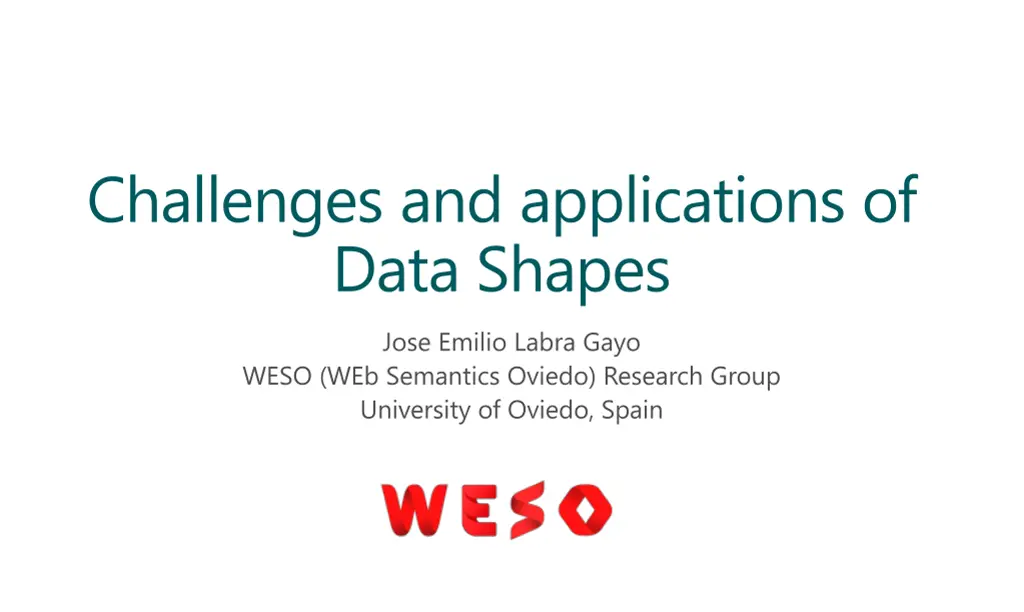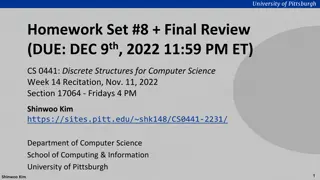
Understanding RDF Graphs and Semantic Technologies
Explore the challenges and applications of RDF data shapes, the RDF data model, and RDF graphs. Learn about ShEx and SHACL, ecosystem at WESO, and how RDF helps in information integration. Discover practical applications in domains like e-Government and e-Health. Semantic technologies since 2004 with WESO research group at University of Oviedo, Spain.
Download Presentation

Please find below an Image/Link to download the presentation.
The content on the website is provided AS IS for your information and personal use only. It may not be sold, licensed, or shared on other websites without obtaining consent from the author. If you encounter any issues during the download, it is possible that the publisher has removed the file from their server.
You are allowed to download the files provided on this website for personal or commercial use, subject to the condition that they are used lawfully. All files are the property of their respective owners.
The content on the website is provided AS IS for your information and personal use only. It may not be sold, licensed, or shared on other websites without obtaining consent from the author.
E N D
Presentation Transcript
Challenges and applications of Data Shapes Jose Emilio Labra Gayo WESO (WEb Semantics Oviedo) Research Group University of Oviedo, Spain
About me Founded WESO (Web Semantics Oviedo) research group Practical applications of semantic technologies since 2004 Several domains: e-Government, e-Health Some books: "Web sem ntica" (in Spanish), 2012 "Validating RDF data", 2017 and software: SHaclEX (Scala library, implements ShEx & SHACL) RDFShape (RDF playground) HTML version: http://book.validatingrdf.com Examples: https://github.com/labra/validatingRDFBookExamples
Contents Short intro to the RDF data model ShEx and SHACL: introduction and comparison Shapes challenges & applications Shapes ecosystem @ WESO
RDF Data Model RDF Graph = set of triples Triple = (subject, predicate, object) Example: http://schema.org/enrolledIn http://example.com/alice http://example.com/cs101 schema:enrolledIn predicate :cs101 object :alice subject N-Triples representation <http://example.com/alice> <http://schema.org/enrolledIn> <http://example.com/cs101> .
RDF Graph RDF Graph = set of triples Basic statement = a simple triple
RDF Graph we can add more statements Circled nodes are IRIs :alice Yellow boxes are literals 23
RDF Graph more statements can be added
RDF Graph and more ...forming a graph which can contain cycles
RDF Graph Graphs can be created independently
RDF Graph and automatically merged RDF helps information integration
RDF syntaxes Several syntaxes: N-triples, Turtle, <http://example.org/alice> <http://example.org/name> <http://example.org/alice> <http://example.org/age> <http://example.org/alice> <http://example.org/enrolledIn> <http://example.org/cs101> . <http://example.org/alice> <http://example.org/knows> <http://example.org/alice> <http://example.org/birthPlace> <http://example.org/Oviedo> . <http://example.org/bob> <http://example.org/name> <http://example.org/bob> <http://example.org/age> <http://example.org/bob> <http://example.org/birthPlace> <http://example.org/Oviedo> . <http://example.org/bob> <http://example.org/enrolledIn> <http://example.org/cs102> . <http://example.org/carol> <http://example.org/name> <http://example.org/carol> <http://example.org/enrolledIn> <http://example.org/cs101> . <http://example.org/cs101> <http://example.org/subject> <http://example.org/cs101> <http://example.org/students> <http://example.org/cs101> <http://example.org/students> <http://example.org/cs102> <http://example.org/subject> <http://example.org/cs102> <http://example.org/students> "Alice" . "23"^^<http://www.w3.org/2001/XMLSchema#integer> . <http://example.org/carol> . "Robert" . "None" . "Carol" . "Programming" . <http://example.org/alice> . <http://example.org/carol> . "Algebra" . <http://example.org/bob> .
Turtle Syntax prefix : <http://example.org/> :alice :name "Alice" ; :age 23 ; :enrolledIn :knows :carol ; :birthPlace :carol :name "Carol" ; :enrolledIn :cs101 :students :alice , :carol ; :subject "Programming" . :bob :name "Robert" ; :age "None" ; :enrolledIn :birthPlace :cs102 :students :bob ; :subject "Algebra" . Some simplifications prefix declarations ; when triples share the subject , when triples share subject and object :cs101 ; :Oviedo . :cs101 . :cs102 ; :Oviedo . Try it: https://goo.gl/pK3Csh
Literals Objects can also be literals Literals contain a lexical form and a datatype Common datatypes: XML Schema primitive datatypes If not specified, a literal has type xsd:string :bob :name "Robert" :age 18 :birthDate ; ; "2010-04-12"^^xsd:date . :bob :name "Robert"^^xsd:string :age "18"^^xsd:integer :birthDate "2010-04-12"^^xsd:date . ; ;
Blank nodes Subjects and objects can also be Blank nodes Blank nodes can have local identifiers :bob :knows _:1 . _:1 :age 23 . or Bob knows someone whose age is 23 = x(:bob :knows x x :age 23) :bob :knows [ :age 23 ] .
Language tagged strings String literals can be qualified by a language tag They have datatype rdfs:langString :spain rdfs:label "Spain"@en ; rdfs:label "Espa a"@es .
...and that's all? Yes, the RDF Data model is simple Simple is better
RDF, the good parts... RDF as an integration language RDF as a lingua franca for semantic web and linked data RDF flexibility & integration Data can be adapted to multiple environments Open and reusable data by default RDF for knowledge representation RDF data stores & SPARQL
RDF, the other parts Consuming & producing RDF Multiple syntaxes: Turtle, RDF/XML, JSON-LD, ... Embedding RDF in HTML Describing and validating RDF content ? Producer Consumer
Why describe & validate RDF? For producers Developers can understand the contents they are going to produce Ensure they produce the expected structure Advertise and document the structure Generate interfaces For consumers Understand the contents Verify the structure before processing it Query generation & optimization Shapes Producer Consumer
Similar technologies Technology Relational Databases XML Schema DDL DTD, XML Schema, RelaxNG, Schematron Json Schema ? Json RDF Fill that gap
Understanding the problem Identifying the shape of graphs... Shapes can describe the form of a node (node constraint) ...and the number of possible arcs incoming/outgoing from a node ...and the possible values associated with those arcs RDF Node ShEx <UserShape> IRI { schema:name schema:knows IRI * } :alice schema:name schema:knows :bob, :carol . "Alice"; xsd:string ; Shape RDF Node that represents a User IRI schema:name schema:knows IRI 0, 1,... string 1
Understanding the problem Repeated properties The same property can be used for different purposes in the same data Example: A product must have 2 codes with different structure :product schema:productID "isbn:123-456-789"; schema:productID "code456" . A practical example from FHIR See: http://hl7-fhir.github.io/observation-example-bloodpressure.ttl.html
Understanding the problem Shapes types Nodes in RDF graphs can have 0, 1 or many rdf:type declarations A type can be used in multiple contexts, e.g. foaf:Person Nodes are not necessarily annotated with discriminating types Nodes with type :Person can represent friends, students, patients,... Different meanings and different structure depending on context Specific validation constraints for different contexts
Shapes vs Ontology Ontologies Shapes instance data Ontologies are usually focused on domain entities RDF validation is focused on RDF graph features (lower level) :Person rdf:type(foaf:Person) = 1 :hasParent :Male = 1 :hasParent :Female Ontology :Person { rdf:type :hasParent @:Person AND { :gender :male } ? ; :hasParent @:Person AND { :gender :female } ? } [ foaf:Person ] ; Shapes Different levels RDF Validation Constraints :alice rdf:type foaf:Person, schema:Person ; :hasParent :bob . :bob rdf:type foaf:Person ; :gender :male . Instance data
Why not using SPARQL to validate? ASK {{ SELECT ?Person { ?Person schema:name ?o . } GROUP BY ?Person HAVING (COUNT(*)=1) } { SELECT ?Person { ?Person schema:name ?o . FILTER ( isLiteral(?o) && datatype(?o) = xsd:string ) } GROUP BY ?Person HAVING (COUNT(*)=1) } { SELECT ?Person (COUNT(*) AS ?c1) { ?Person schema:gender ?o . } GROUP BY ?Person HAVING (COUNT(*)=1)} { SELECT ?Person (COUNT(*) AS ?c2) { ?S schema:gender ?o . FILTER ((?o = schema:Female || ?o = schema:Male)) } GROUP BY ?Person HAVING (COUNT(*)=1)} FILTER (?c1 = ?c2) } Pros: Expressive Ubiquitous Cons Expressive Idiomatic many ways to encode the same constraint Example: Define SPARQL query to check: There must be one schema:name which must be a xsd:string, and one schema:gender which must be schema:Male or schema:Female
ShEx and SHACL 2013 RDF Validation Workshop Conclusions of the workshop: There is a need of a higher level, concise language for RDF Validation ShEx initially proposed (v 1.0) 2014 W3c Data Shapes WG chartered 2017 SHACL accepted as W3C recommendation 2017 ShEx 2.0 released as Community group draft 2019 ShEx adopted by Wikidata
Short intro to ShEx ShEx (Shape Expressions Language) Concise and human-readable Syntax similar to SPARQL, Turtle Semantics inspired by regular expressions & RelaxNG 2 syntaxes: Compact and RDF/JSON-LD Official info: http://shex.io Semantics: http://shex.io/shex-semantics/, primer: http://shex.io/shex-primer
ShEx implementations and playgrounds Implementations: shex.js: Javascript SHaclEX: Scala (Jena/RDF4j) PyShEx: Python shex-java: Java Ruby-ShEx: Ruby Elixir Online demos & playgrounds ShEx-simple RDFShape ShEx-Java ShExValidata Wikishape
Simple example Prefix declarations as in Turtle/SPARQL prefix schema: <http://schema.org/> prefix xsd: <http://www.w3.org/2001/XMLSchema#> <User> IRI { schema:name schema:knows @<User> * } xsd:string ; Nodes conforming to <User> shape must: Be IRIs Have exactly one schema:name with a value of type xsd:string Have zero or more schema:knows whose values conform to <User>
RDF Validation using ShEx Data :alice schema:name schema:knows :alice "Alice" ; Schema . <User> IRI { schema:name schema:knows @<User> * } xsd:string ; :bob schema:knows :alice ; schema:name "Robert". :carol schema:name "Carol", "Carole" . Shape map :dave schema:name 234 . :alice@<User>, :bob @<User>, :carol@<User>, :dave @<User>, :emily@<User>, :frank@<User>, :grace@<User> :emily foaf:name "Emily" . :frank schema:name "Frank" ; schema:email <mailto:frank@example.org> ; schema:knows :alice, :bob . :grace schema:name "Grace" ; schema:knows :alice, _:1 . Try it (RDFShape): https://goo.gl/97bYdv Try it (ShExDemo):https://goo.gl/Y8hBsW Try it (RDFShape): https://goo.gl/97bYdv Try it (ShExDemo):https://goo.gl/Y8hBsW _:1 schema:name "Unknown" .
Validation process Input: RDF data, ShEx schema, Shape map Output: Result shape map ShEx Schema :User { schema:name schema:knows @:User * } xsd:string ; Result shape map Shape map ShEx Validator :alice@:User, :bob@:User, :carol@!:User :alice@:User, :bob@:User, :carol@:User RDF data :alice schema:name schema:knows :alice "Alice" ; . :bob schema:knows :alice ; schema:name "Robert". :carol schema:name "Carol", "Carole" .
Example with more ShEx features :AdultPerson EXTRA rdf:type { rdf:type [ schema:Person ] ; :name xsd:string :age MinInclusive 18 :gender [:Male :Female] OR xsd:string ; :address @:Address ? :worksFor @:Company + } :Address CLOSED { :addressLine xsd:string {1,3} ; :postalCode /[0-9]{5}/ ; :state @:State ; :city xsd:string } :Company { :name xsd:string :state @:State ; :employee @:AdultPerson * ; } :State /[A-Z]{2}/ ; ; ; ; :alice rdf:type :Student, schema:Person ; :name "Alice" ; :age 20 ; :gender :Male ; :address [ :addressLine "Bancroft Way" ; :city "Berkeley" ; :postalCode "55123" ; :state "CA" ] ; :worksFor [ :name "Company" ; :state "CA" :employee :alice ] . ; ; Try it: https://tinyurl.com/yd5hp9z4
SHACL SHACL (Shapes Constraint Language) W3C recommendation: https://www.w3.org/TR/shacl/ (July 2017) RDF vocabulary 2 parts: SHACL-Core, SHACL-SPARQL
SHACL implementations Name Parts Language - Library Java (Jena) Comments Topbraid SHACL API SHACL Core, SPARQL Used by TopBraid composer SHACL playground SHACLEX pySHACL SHACL Core SHACL Core SHACL Core, SPARQL Javascript (rdflib.js) Scala (Jena, RDF4j) Python (rdflib) http://shacl.org/playground/ http://rdfshape.weso.es https://github.com/RDFLib/pySHAC L http://wimmics.inria.fr/corese https://github.com/AKSW/RDFUnit Corese SHACL RDFUnit SHACL Core, SPARQL SHACL Core, SPARQL Java (STTL) Java (Jena)
Basic example prefix : <http://example.org/> prefix sh: <http://www.w3.org/ns/shacl#> prefix xsd: <http://www.w3.org/2001/XMLSchema#> prefix schema: <http://schema.org/> :UserShape a sh:NodeShape ; sh:targetNode :alice, :bob, :carol ; sh:nodeKind sh:IRI ; sh:property :hasName, :hasEmail . :hasName sh:path schema:name ; sh:minCount 1; sh:maxCount 1; sh:datatype xsd:string . :hasEmail sh:path schema:email ; sh:minCount 1; sh:maxCount 1; sh:nodeKind sh:IRI . :alice schema:name "Alice Cooper" ; schema:email <mailto:alice@mail.org> . :bob schema:firstName "Bob" ; schema:email <mailto:bob@mail.org> . :carol schema:name "Carol" ; schema:email "carol@mail.org" . Data graph Shapes graph Try it. RDFShape https://goo.gl/ukY5vq
Same example with blank nodes prefix : <http://example.org/> prefix sh: <http://www.w3.org/ns/shacl#> prefix xsd: <http://www.w3.org/2001/XMLSchema#> prefix schema: <http://schema.org/> :UserShape a sh:NodeShape ; sh:targetNode :alice, :bob, :carol ; sh:nodeKind sh:IRI ; sh:property [ sh:path schema:name ; sh:minCount 1; sh:maxCount 1; sh:datatype xsd:string ; ] ; sh:property [ sh:path schema:email ; sh:minCount 1; sh:maxCount 1; sh:nodeKind sh:IRI ; ] . :alice schema:name "Alice Cooper" ; schema:email <mailto:alice@mail.org> . :bob schema:firstName "Bob" ; schema:email <mailto:bob@mail.org> . :carol schema:name "Carol" ; schema:email "carol@mail.org" . Data graph Shapes graph Try it. RDFShape https://goo.gl/ukY5vq
Some definitions about SHACL Shape: collection of targets and constraints components Targets: specify which nodes in the data graph must conform to a shape Constraint components: Determine how to validate a node Shape :UserShape a sh:NodeShape ; sh:targetNode :alice, :bob, :carol ; sh:nodeKind sh:IRI ; sh:property :hasName, :hasEmail . :hasName sh:path schema:name ; sh:minCount 1; sh:maxCount 1; sh:datatype xsd:string . . . . target declarations constraint components
Validation Report Output of validation process = list of violation errors No errors RDF conforms to shapes graph [ a sh:ValidationReport ; true [ a sh:ValidationReport ; false ; [ sh:ValidationResult ; :bob ; sh:conforms ]. sh:conforms sh:result a sh:focusNode sh:message "MinCount violation. Expected 1, obtained: 0" ; sh:resultPath schema:name ; sh:resultSeverity sh:Violation ; sh:sourceConstraintComponent sh:MinCountConstraintComponent ; sh:sourceShape :hasName ] ; ...
SHACL processor :UserShape a sh:NodeShape ; sh:targetNode :alice, :bob, :carol ; sh:nodeKind sh:IRI ; sh:property :hasName, :hasEmail . :hasName sh:path schema:name ; sh:minCount 1; sh:maxCount 1; sh:datatype xsd:string . . . . Shapes graph Validation report SHACL Processor [ a sh:ValidationReport ; true sh:conforms ]. Data Graph :alice schema:name "Alice Cooper" ; schema:email <mailto:alice@mail.org>. :bob schema:name "Bob" ; schema:email <mailto:bob@mail.org> . :carol schema:name "Carol" ; schema:email <mailto:carol@mail.org> .
Longer example :AdultPerson a sh:NodeShape ; sh:property [ sh:path rdf:type ; sh:qualifiedValueShape [ sh:hasValue schema:Person ]; sh:qualifiedMinCount 1 ; sh:qualifiedMaxCount 1 ; ] ; sh:targetNode :alice ; sh:property [ sh:path :name ; sh:minCount 1; sh:maxCount 1; sh:datatype xsd:string ; ] ; sh:property [ sh:path :gender ; sh:minCount 1; sh:maxCount 1; sh:in (:Male :Female); ] ; sh:property [ sh:path :age ; sh:maxCount 1; sh:minInclusive 18 ] ; sh:property [ sh:path :address ; sh:node :Address ; sh:minCount 1 ; sh:maxCount 1 ] ; sh:property [ sh:path :worksFor ; sh:node :Company ; sh:minCount 1 ; sh:maxCount 1 ]. In SHACL In ShEx :Address a sh:NodeShape ; sh:closed true ; sh:property [ sh:path :addressLine; sh:datatype xsd:string ; sh:minCount 1 ; sh:maxCount 3 ] ; sh:property [ sh:path :postalCode ; sh:pattern "[0-9]{5}" ; sh:minCount 1 ; sh:maxCount 3 ] ; sh:property [ sh:path :city ; sh:datatype xsd:string ; sh:minCount 1 ; sh:maxCount 1 ] ; sh:property [ sh:path :state ; sh:node :State ; ] . :State a sh:NodeShape ; sh:pattern "[A-Z]{2}" . :AdultPerson EXTRA a { a :name xsd:string :age MinInclusive 18 :gender [:Male :Female] OR xsd:string ; :address @:Address ? :worksFor @:Company + } :Address CLOSED { :addressLine xsd:string {1,3} ; :postalCode /[0-9]{5}/ ; :state @:State ; :city xsd:string } :Company { :name xsd:string :state @:State ; :employee @:AdultPerson * ; } :State /[A-Z]{2}/ [ schema:Person ] ; ; ; :Company a sh:NodeShape ; sh:property [ sh:path :name ; sh:datatype xsd:string ] ; sh:property [ sh:path :state ; sh:node :State ] ; sh:property [ sh:path :employee ; sh:node :AdultPerson ; ] ;. ; ; ; Its recursive!!! (not well defined SHACL) Implementation dependent feature Try it: https://tinyurl.com/ycl3mkzr
ShEx and SHACL compared Similarities Similar goal: describe and validate RDF graphs Both employ the word "shape" Node constraints similar in both languages Constraints on incoming/outgoing arcs Both allow to define cardinalities Both have RDF syntax Both have an extension mechanism
ShEx and SHACL compared Main differences ShEx Structure definition Compact syntax + RDF Only structure {1,1} No Part of the language Part of the language SHACL Constraint checking RDF Structure + target decls. {0,*} SHACL specific entailment Undefined Conjunction by default Requires qualifiedValueShapes SPARQL like Part of the language SHACL-SPARQL Target declarations Validation report Underlying philosophy Syntax Notion of shape Default cardinalities Shapes and inference Recursion Repeated properties Property paths Property pair comparisons Extension mechanism Validation triggering Result of validation Nested shapes Unsupported in current version Semantic actions Query shape map Result shape map
Shapes applications and challenges Theoretical foundations of ShEx/SHACL Generating shapes from data Validation Usability RDF Stream validation Continuous integration Programming with shapes Schema ecosystems Wikidata Solid
Theoretical foundations of ShEx/SHACL Conversion between ShEx and SHACL SHaclEX library converts subsets of both Challenges Recursion and negation Performance and algorithmic complexity Detect useful subsets of the languages Convert to SPARQL Schema/data mapping Shapes Shapes ShEx SHACL
Generating Shapes from Data Useful use case in practice Knowledge Graph summarization Some prototypes: ShExer, RDFShape, ShapeArchitect Shape Expression generated for wd:Q51613194 Shapes Try it with RDFShape: https://tinyurl.com/y8pjcbyf infer RDF data
Validation usability Learning from users Early adopters: WebIndex, HL7 FHIR, Eclipse Lyo, GenWiki, Improve error information/visualization/navigation/repairing Authoring/visualization tools Propose annotation sets UI generation Error reporting/suggestion (SHOULD/MUST/ ) Shapes
RDF Stream validation Validation of RDF streams Challenges: Incremental validation Named graphs Addition/removal of triples Shapes Stream RDF data Stream Validation results Sensor Validator
Ontological infrastructure Coexistence between ontologies/shapes Shapes can validate the behaviour of inference systems Shapes pre- and post- inference TDD and continuous integration based on shapes Example: Gene Ontology project https://github.com/geneontology/go-shapes/ Continuous Integration server Ontology engineer Ontological infrastructure Control version system (git) Ontologies Endpoint SPARQL Ontology publication system Shapes library Triple Store Test data
Programming with shapes Domain model based on Shapes Clean architecture pattern Domain model as central element Simple classes (POJO): Plain Old Java Objects Shapes synchronization Application logic and services based on domain model UML Diagrams Domain model Shapes library Syncrhonization Semantic architecture Ontological infrastructure
Schema ecosystems: Wikidata In May, 2019, Wikidata announced ShEx adoption New namespace for schemas Example: https://www.wikidata.org/wiki/EntitySchema:E2 It opens lots of opportunities/challenges Schema evolution and comparison





















